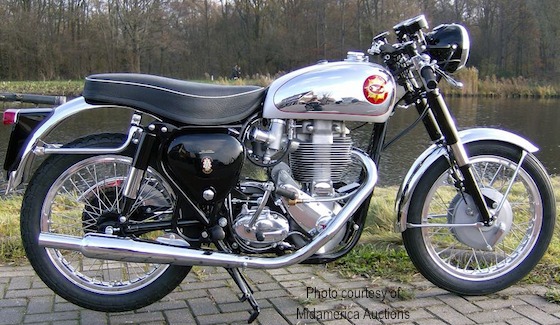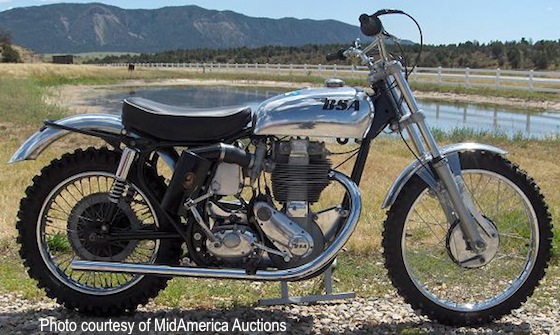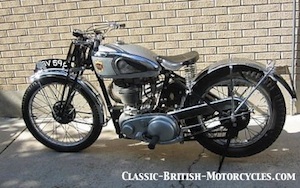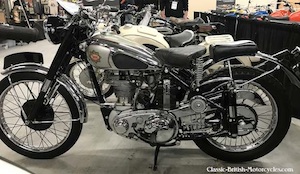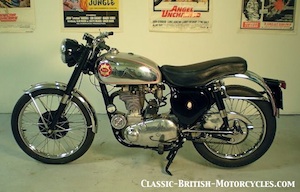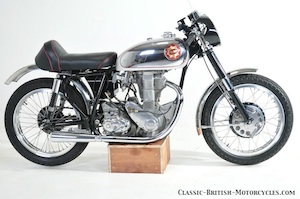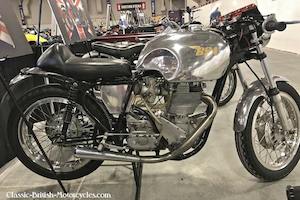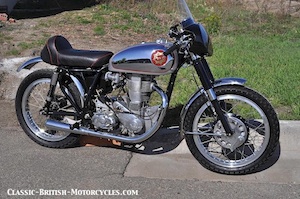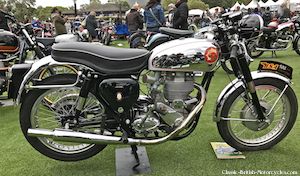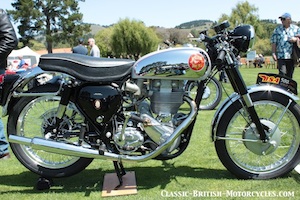ABOVE: The 1960 BSA Gold Star Clubman was a high-performance roadster. The Gold Star also earned major off-road competition cred during its 25-year career.
GOLDIE LORE
The BSA Gold Star was one of the most successful motorcycles of all time, both in the showroom & on the track. It’s ancient design was outdated almost at its inception & yet it thundered on through history, taking on all comers. Light, strong, powerful & bulletproof, the “Goldie” gained a loyal following over the decades. When it was finally retired in 1963, nothing ever sold as well or did as well at the track. The Gold Star, as it turned out, was BSA Motorcycles’ seminal & most successful model & the one they became known for.
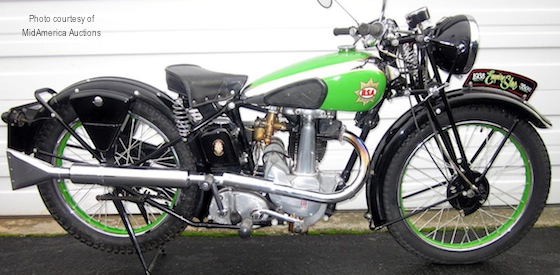
ABOVE: 1938 BSA Empire Star, the precursor to the BSA Gold Star.
EARLY GOLD STAR HISTORY
In 1937 the fast BSA was the Empire Star & Wal Handley came out of retirement to ride one in a 3-lap race at Brooklands. His fastest lap was 107.5mph & anything over 100mph earned a coveted “Gold Star” pin. BSA was so proud that they named their top-of-the-line single the BSA Gold Star. The first Gold Stars started out as BSA M24s, with an all-alloy engine, an Electron alloy gearbox & a lightweight frame. Alas, just as development & production got underway, the War intervened & all civilian production was diverted into producing war materiale. These pre-war BSA Gold Stars moved from sports to fast tourer, but failed to find much favor with the buying public. Fewer than 500 Gold Stars were produced prior to the war.
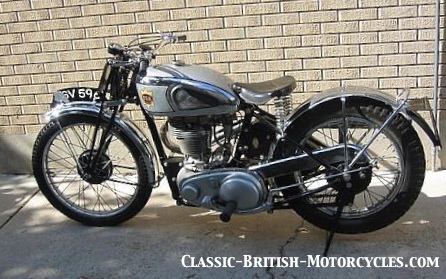
ABOVE: This 1939 BSA Gold Star shows the early formula: rigid frame and springer front end.
WAR IS OVER, RACE IS ON!
At the end of World War 2, BSA was the largest producer of motorcycles in the world & one of the largest companies in the British Empire. As civilian markets became starved for motorcycles, BSA ramped up production to meet demand. At the time, they were producing only single cylinder models. In 1948, BSA revived the Gold Star name with the B32 in 350cc. These were custom-ordered then built by hand to the customers’ specifications & bench tested. This would become a Gold Star tradition.
BROADENING THE GOLD STAR LINE
The BSA Bold Star was available in two displacements, the 348cc B32 & the 499cc B34. The new Gold Star engines used an all-alloy cylinder barrel & head which was 20 pounds lighter than the cast iron unit of the B-series singles. These hand-built engines were available with different compression ratios, cams, carburetors & exhaust systems, and two different cylinder heads, one for the Trials version & the other for everything else. They were then run on a dynamometer & the test results with power output were shipped with the bike. Besides engine specs, the BSA Gold Star could be ordered in Touring, Trials, ISDT, Scrambles, Racing or Clubmans trim.
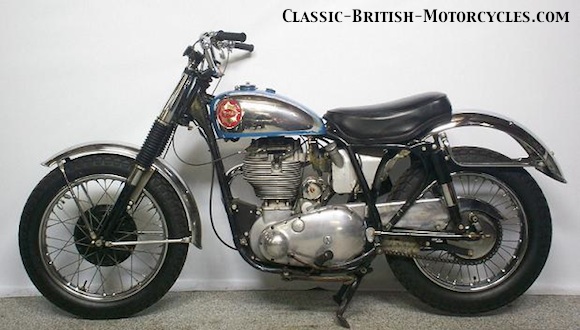
ABOVE: 1962 BSA Gold Star Catalina Scrambler.
GOLDEN YEARS OF THE GOLDIE
In 1949, the BSA B34 500 Gold Star got a new, stronger crankshaft & main bearings. The B32 350 would follow the following year. Both got a larger, more powerful front 8-inch front brake. In 1952, the 500 got a new Bert Hopwood-designed head, with the 350 following the next year.
NEW SWINGARM FRAMES
The Gold Star got a new frame with swingarm rear suspension in 1953, along with a new & improved gearbox. The new frame spread across the rest of the B-range of singles the following year. This new gearbox allowed BSA to offer more optional ratios. With the new frame, there would be few changes with frame & cycle gear throughout the rest of the Goldie’s life. But the engines still had further development stages awaiting them.
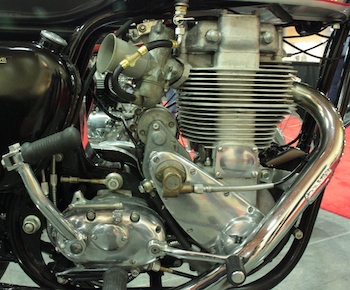
CB & BB MODELS
For 1954, the Gold Star Clubmans & Road Racing versions got a new engine designated CB, as opposed to the BB engines in the other models. The CB had more finning on the top end & a backswept exhaust that gave them a striking appearance. Internally, the 500 got a shorter connecting rod, & a strengthened crankshaft with oval flywheels (to provide clearance for the piston). Valve adjustment was now achieved via eccentric rocker shafts (allowing a lighter rocker arm with no adjuster nuts). The Amal GP carburetor had a remote float bowl. Both BB & CB continued into 1955 in all but ISDT trim.
DB MODELS
The DB model designation began in 1955 & used CB running gear & the engines were similar but had a much improved crankshaft oil feed. The 350s also got a revised barrel with a thicker liner. The front brake drums were finned & there was a model-specific silencer (muffler).
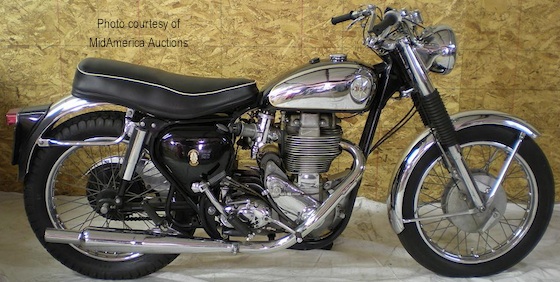
ABOVE: 1959 BSA Gold Star touring version.
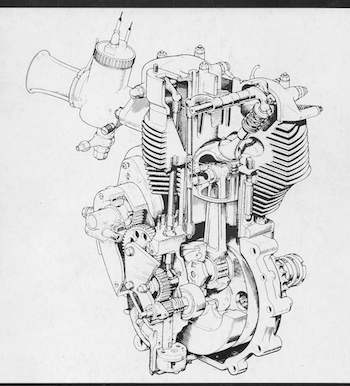
By the end of 1955, the CB & BB models were dropped along with the Trials version, leaving only the DB types. A new model, the DBD available only in 499cc was introduced with 1-1/2″ Amal GP, the largest available & a special tapered silencer. Two new options also made their debut this year: the 5-gallon alloy tank & the famous full-width 190mm front brake. The DBD was the final development in the BSA Gold Star lineage & continues to be the most desirable Goldie, and Clubman to collectors & enthusiasts.
MODELS THIN DOWN
At the end of 1956, the Gold Star Touring & Road versions were dropped & in 1957 the Road Racing, the DB & the entire 350 Gold Star line followed. This left only the DBD34 Gold Star Clubmans & the Scrambles models for 1958, with little change from ’57. The DB32 350 Gold Star returned in 1959 but by 1960 was being built on by special order.
THE END DRAWS NEAR
Despite a brilliant career & incredible success both on the track & in the showroom, the BSA Gold Star had run its course & the end was inevitable. The big single was no longer competitive in road racing against twins & off-road racing was now being dominated by lightweight 2-strokes. The Goldie had been past up by technology. BSA Motorcycles could have squeezed another year or so out of it, perhaps, there surely was enough demand. But Lucas Electrics had stopped making magnetos & BSA was running out of their stockpile. By the end of the 1963 model year, BSA ceased producing Gold Stars. It was replaced in 1964 with a new line of unit-construction singles lead by the B50. While more modern in every way, they failed to attract the kind of attention & respect that the Gold Star had in spades.
ABOVE: 1962 BSA Gold Star Catalina, this one a pure off-road competition model.
COMPETITION SUCCESSES
THE GOLD STAR’S MISSION
The BSA Gold Star was always intended to be a purpose-built, hand-assembled race machine, not a street bike that was transformed into a racer. In fact, the official 1961 BSA Catalogue is quoted as saying: “The Clubman’s model Gold Star has been developed for competitions in road and short circuit events, and its specification is such that it is neither intended nor suitale for road use as a touring motorcycle.” Despite being available with lights, these bikes were factory racers, no question about it.
RACING IN THEIR BLOOD
As mentioned earlier, even the name was derived from its racing lineage when in 1937 Wal Handley won the Brooklands TT & was awarded a Gold Star pin for averaging over 100mph lapspeed. When postwar production resumed, BSA needed to meet a homologation requirement for the 1949 Clubmans TT. So just over 100 348cc Gold Stars were hand-built (they were all hand-built). 21 bikes were entered in the 1949 350 Junior TT, an event that would be dominated by Gold Stars for the next 8 years. The new swingarm frame in 1953 ushered in more success, including the 1954 Senior TT which was won by Eddie Dow on a 500 Goldie. To boost sales, in 1954 BSA brought a team to the Daytona 200-mile beach race with a mix of Gold Stars & Shooting Star twins assembled by Roland Pike. They took 1st, 2nd, 3rd, 4th, 5th, 8th & 16th places. In 1956, the DBD34 with its 110mph top speed (it could hit 60mph in first gear!), dominated the Isle of Man Clubmans TT. In America, BSA Gold Stars also dominated off-road racing, motocross, scrambles & desert racing well past the end of their production in 1963.
BSA Gold Star YEAR-BY-YEAR
1951 GOLD STAR
Updated 3/9/18
This Gold Star road racer shows just how versatile the “Goldie” was. It dominated racing off road, made a great street bike & was extremely competitive in road racing.
Check out these BSA BOOKS
The BSA Gold Star: Motorcycle History
Illustrated Bsa Buyer’s Guide (Motorbooks International Illustrated Buyer’s Guide)
BSA Unit Singles: The Complete Story including the Triumph Derivatives
Bsa Motor Cycles: Since 1950 (British Motor cycles since 1950)
BSA 500 & 650 Twins: The Essential Buyer’s Guide
How to Restore Triumph Trident T150/T160 & BSA Rocket III: YOUR step-by-step colour illustrated guide to complete restoration (Enthusiast’s Restoration Manual)
For more like these, visit our BSA BOOK STORE
 |
PLEASE BUY MY NEW E-BOOK HERE 12 Chapters & over 100 original photos. My best work yet. ONLY $4.99! Thank you, Andy Tallone, your humble author Click here to buy now: |


